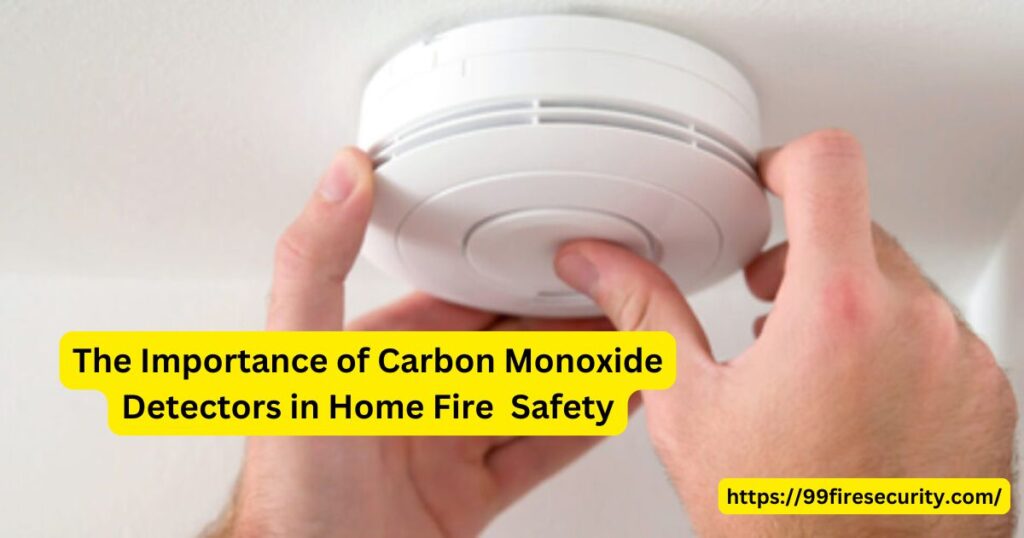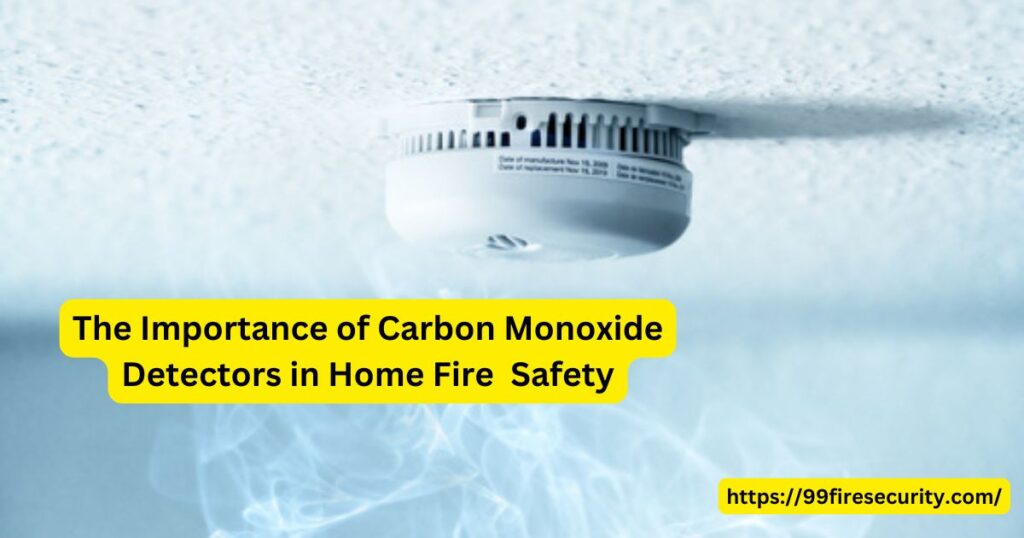Introduction
When it comes to homeownership, home security should become one of your top priorities. Although most of us worry about locking up our homes against visible threats — a break-in, a fire — we often forget about invisible hazards like carbon monoxide (CO). Known as the “silent killer,” carbon monoxide is a colorless, odorless gas that is a serious threat to life. The need to install carbon monoxide detectors is not a luxury, it is a necessity. In this article, we’ll discuss the reasons that these detectors are an essential part of your home’s fire protection plan.
Understanding Carbon Monoxide
What is Carbon Monoxide?
Carbon monoxide detectors is a deadly gas that is released when burning natural gas, wood, charcoal or gasoline. Unlike smoke or flames, Carbon monoxide detector offers no visual or olfactory cue, making it super safe. Gas stoves and fireplaces, hot water heaters and other common household appliances often cause CO emissions when they are not serviced properly.
Sources of Carbon Monoxide in Houses
The carbon monoxide detectors can be generated from many sources. Some of the most common causes include defective heating systems, obstructed chimneys and gas-fueled generators. Even vehicle emissions can enter homes if a car is idling in an attached garage. Knowledge of these sources is the first step in prevention.
Health Dangers of Carbon Monoxide Exposure
Carbon monoxide detectors exposure causes flu-like symptoms such as headaches, dizziness and nausea. Long-term exposure can lead to brain damage, organ failure and death. According to the C.D.C., carbon monoxide detectors poisoning sends thousands to the emergency stay each year and accounts for some 400 deaths each year in the United States alone.

The Link Between Carbon Monoxide and Fires
Role of Fires in CO Emission
When materials such as wood, plastic and fabrics burn, they give off a cocktail of gases, including carbon monoxide detectors. When oxygen in a room is consumed by a fire, the incomplete combustion that can result generates even greater concentrations of carbon monoxide detectors and adds to the harm.
Why CO is Deadly During Fires
Smoke may alert you to danger during a fire, but carbon monoxide detectors often leaves you in the dark. High levels can disrupt judgment, compromising escape. Firefighters often see CO poisoning cases in survivors pulled from house fires.

The Importance of Carbon Monoxide Detectors in Fire Safety
How CO Detectors Work
Carbon monoxide detectors sense there air quality. If CO levels exceed a safe limit, the detector triggers an alarm, alerting occupants to evacuate or ventilate the area in question. Higher-end models might even have digital displays that report readings of CO levels.
Where to Place CO Detectors in the House
In order for CO detectors to do their job, placement is key. Put detectors close to your sleeping areas and on each level of your home. Don’t put them right next to windows or vents, where airflow can interfere with detection. Some units are designed to detect both CO and smoke, providing dual protection.
Carbon Monoxide Exposure Prevention
Routine Maintenance of Appliances
Preventing CO leaks requires proper maintenance. Have an annual inspection done on your heating system and chimney — each heating season. It’s also important that your gas appliances are installed or serviced by certified professionals.
Avoiding Common Mistakes
Do not use portable generators indoors or in enclosed spaces, and do not leave vehicles idling in garages. Make sure gas appliances are well-ventilated and that vents and flues aren’t blocked by snow or debris.
Legal and Regulatory Aspects
Laws Mandating CO Detectors
Many states and local jurisdictions have laws mandating polygrip carbon monoxide detectors in residential buildings. California, for instance, requires CO detectors in all single-family homes that have an attached garage or that contains fuel-burning appliances. These laws seek to decrease avoidable CO-related events and guarantee that landlords provision rental properties with this vital safeguard.
Construction Codes and Safety Regulations
Many building codes require CO detectors in new construction or remodeling projects. Aside from ensuring obedience to the law, compliance upholds the safety of occupants. Increased fire and air quality safety provides courtesy of Federal Emergency Management Agency (FEMA): Builders are advised to install combination smoke and CO detectors.
How to Choose the Appropriate CO Detector
Key Features to Look For
In selecting a CO detector, look for important features like battery backup, audible alarms and digital readouts of CO levels. Models with long-lasting batteries or plug in options that have a battery backup are especially reliable during power outages. Some advanced detectors can connect to your smart home systems and alert you via mobile devices in real time.

Brands and Certifications
“You want to buy a detector that’s certified by an organization, such as Underwriters Laboratories (UL), that has the reputation given through testing, that is going to make you safe.” I recommend brands like First Alert and Kidde, which offer a variety of reliable detectors, lots of them basic but also some smart detectors with integrated monitoring features.
Cost-Benefit Analysis
Affordability of CO Detectors
Carbon monoxide detectors are very inexpensive, with basic models available for as little as $20. Premium models can range around $100 while additional comfort and innovative options are also available. The financial burden far less than that with loss of lives or rates of hospitalization from CO intoxication.
Advantages of Early Carbon Monoxide Detection
Early diagnosis of CO can spare people’s lives, save them from serious health problems, and keep property from damage. A detector can warn you of a problem before it is life threatening, allowing you to promptly fix the source of the CO emissions.
Trustworthiness in AI: Case Studies and Real-Life Incidents
Lives Saved by CO Detectors: Anecdotes
In Wisconsin a family was saved when the CO detector alerted them of a gas leak from a faulty furnace. They were evacuated and contacted emergency services quickly enough to avert tragedy. Such incidents highlight the potentially life-saving value of CO detectors.
Tragic If A CO Detector Isn’t On Duty
What happened In Michigan: Family of four dead from carbon monoxide detectors poisoning after indoor generator use during power outage These types of cases demonstrate the severe consequences of not adhering to CO safety measures.
Why Smart CO Detectors are Beneficial
Smart CO detectors may also provide features such as smartphone alerts, audible notifications, and networking with your home automation systems. These gadgets can link to smart thermostats to turn off heating and air conditioning units during CO leaks, reducing risk of exposure when you’re home.
Advanced Features to Consider
Many smart CO detectors are multi-sensor, meaning they will detect smoke and temperature changes as well as CO levels. Certain models are also able to self-test, ensuring that they can function without human intervention.
Common Myths and Misconceptions About CO Detectors
Common Misunderstandings
Many homeowners mistakenly think smoke detectors also detect carbon monoxide detectors, but the two serve different functions. Another myth: CO detectors are not needed if there are no gas appliances in the home. In actual use, CO is still capable of being introduced into the spaces (e.g., from vehicles outside or adjacent to properties).
Debunking the Myths
Experts note that it is always best to have stand alone CO detectors. Research demonstrates that households equipped with CO detectors have a much lower incidence of CO poisoning than those that do not possess CO detectors.
Preparing for and Responding to Emergencies
What to Do When the Carbon Monoxide Alarm Goes Off
If your CO detector activates, get out of the house right away and call emergency services. Until then, do not reenter unless professionals have indicated it’s safe to do so. Open windows and turn off fuel-burning appliances if you can.
Critical Component of a Family Safety Plan
The first thing to do is have a safety plan. Practice evacuation drills with your family regularly, and choose safe meeting locations outside your home. Designate roles, such as calling emergency services, for a quick response in case of an actual emergency.
Innovations in CO Detectors
Technology has come a long way since CO detectors literally, beeped and alerted you with low battery chirps. Such improvements allow for predictive maintenance alerts and integration with larger home security systems.
3 Trends in Fire and Home Safety
The industry is heading towards eco-friendly and energy-efficient detectors. Models now include solar-powered and self-calibrating options, an increasingly popular pick for environmentally-minded home experts.
Conclusion
Carbon monoxide detectors are an integral part of home fire safety, offering early warnings that are life-saving and preventing severe health consequences. By familiarizing yourself with what produces CO, where to locate detectors and how to care for appliances, you can help decrease the risks of carbon monoxide detectors poisoning. Don’t wait for a tragedy to remind you how essential this lifesaving device can be. Join us and take action now to save your home and family.
FAQs
How often do I need to replace my carbon monoxide detector?
Depending on the manufacturer, most CO detectors should be replaced every 5 to 7 years. The label on the device itself should provide precise recommendations.
Will CO detectors pick up natural gas leaks?
A CO detector will not detect natural gas No. For natural gas, you’ll need a separate gas detector.
How long does a typical CO detector last?
Depending on the model, the lifespan may vary, but a good detector should last anywhere from 5 to 10 years. Make sure to periodically test out your device to know if it works properly.
Do I need to have CO detectors professionally installed?
Not necessarily. Most CO detectors are simple to install, coming with handy instructions. Hardwired or interconnected systems are best installed by professionals, however.
Are combined smoke and CO detectors useful?
Yes, combo detectors are super great and they save space by providing two levels of protection. Make sure the one you select has safety certifications for smoke and CO detection.


